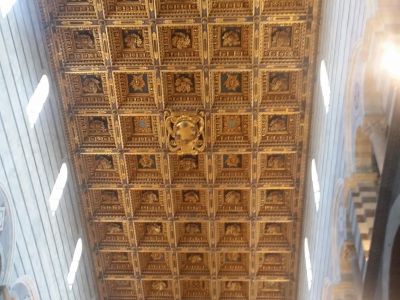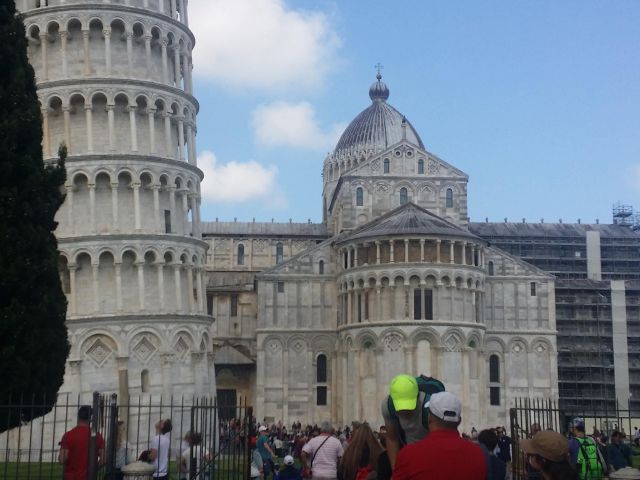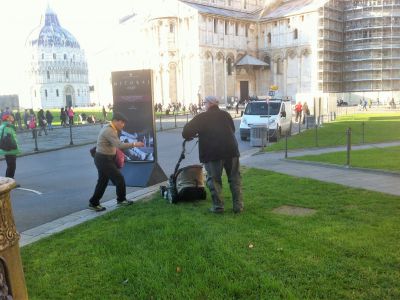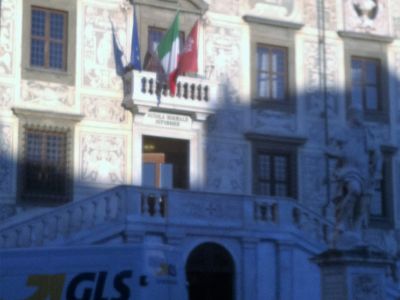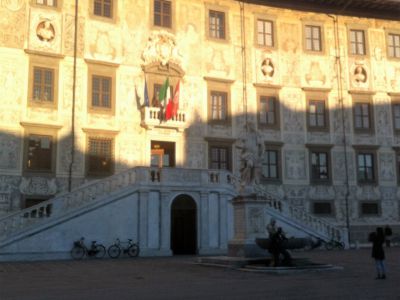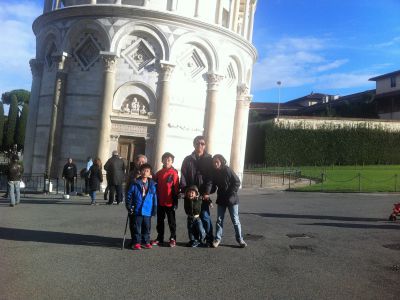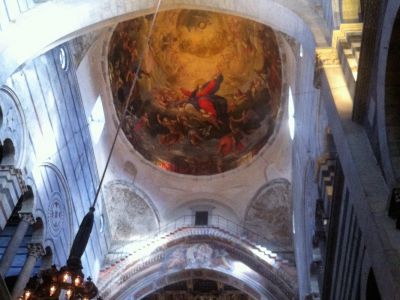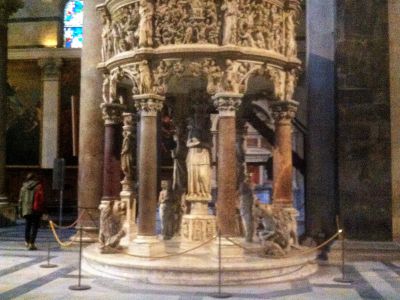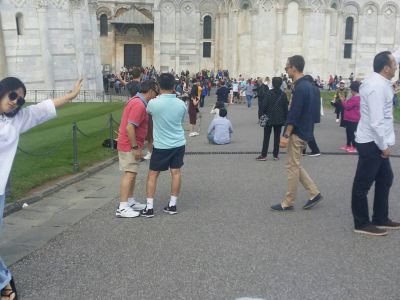PISA 90.000 inhabitants According to the legend, Pisa was founded by a
Trojan population coming from a
Greek city having the same name:
Pisa. Other scholars differently think that it was founded during the Etruscan Age and named Pisa after the Etruscan meaning, “mouth of the river”. This theory makes sense because the Arno river, the most important river in the whole region, empties into this area. According to another theory Pisa was of Roman origin or that was even founded during the Paleolithic Age (XIIth century BC). The most reliable theory is the Etruscan one, also thanks both to its strategic position against the attacks of the Ligurian population and to the trading development with
Bologna, Sardinia, Volterra, and Populonia. The whole story began when in the VIth century the city was trading with the Phoenician, Gaul and Greek populations thanks to its original position near to the sea that enabled the use of ports like
San Piero a Grado, San Rossore and the Port of Livorno (that at that time was called Porto Pisano and was located in the exact point of the mouth of Arno). Over time only the pears along and at the mouth of Arno. In 180 BC, after various fights against the
Gaul, Ligurian and Carthaginian populations, Pisa became a Roman colony. From 600 AD Pisa became an important area of the Tuscia region thanks to the presence of Arno and Auser river that enabled communication and transport routes in the whole region. Pisa therefore became an important port area for trading exchanges with
Corsica, Spain, Sardinia and France. During the Crusades Age Pisa gained more and more importance because it became more influent also in the whole
Mediterranean area. Just to remember, Crusades were 9 wars that were fought between the XIth and the XIIth century. These wars were between Christians coming from Europe against Muslims coming from Asia. The aim of these wars was to banish the Muslim religion in those areas by replacing it with the Christian one because there Christ was born. That is why the other name of Crusades was Religion Wars. Besides its participation to the religion wars, Pisa was also, together with Genoa, Amalfi, and Naples one of the four maritime republics. The maritime republics where those Italian cities that after the Xth century played an important economic role thanks to their position near to the sea. In order to become a maritime republic, a city had to have an independent government (that is an Oligarchic or Aristocratic Republic), to have coined a new currency, to have an Ambassador who was responsible for the maritime trade with the other ports of the Mediterranean area, and to have participated in the religion wars.
The maritime republics were constantly at war one against each other in order to gain as much territory as possible in the Mediterranean area. Pisa wanted to expand towards
Corsica and France and this created unrest with
Genoa, Florence, Volterra, Massa, and Lucca and other cities nearby. All these cities wanted to have a direct access to the Mediterranean Sea. Pisa also wanted to conquer the
Adriatic territories and for this reason was at war with Venice; but the Tuscan city was also interested in
Civitavecchia,
Amalfi and
Portovenere. In all these wars Pisa was supported both by the various Popes and by the German emperors. After the Meloria war Pisa was defeated by Genoa in 1284 and Porto Pisano in Livorno was destroyed. The fleet of Pisa was finally defeated in Sardinia by the Aragonese population. Pisa also conquered other cities, like for example
Lucca and
Montecatini, and tried to conquer also Florence, which yet won the Cascina battle. In 1406 thanks to the corruption of
Gambacorta, Florence conquered Pisa, led by
Gino Capponi. By doing so,
Florence eventually had its direct access to the
Mediterranean Sea. This is only a short summary of all the wars in which Pisa was involved. Nowadays Pisa is an important university center where the worldwide famous
is located. The university was founded by Napoleon in 1810 and is nowadays the most important in Italy. In this university hub it is possible to study Arts, Philosophy, Natural Sciences and Physics.
Important sights of the city:
Piazza dei Miracoli: the complex of Piazza dei Miracoli is composed by the
Cathedral, the baptistery, the leaning Tower, the monumental cemetery and the Museo dell’Opera del Duomo.
- The Cathedral: the building yard opened in 1063 by Buscheto and closed in 1092. The church presents a Romanesque style and was consecrated in 1182 by Pope Gelasius II. Various artists decorated both the internal and the external part of the Cathedral, such as Bonanno Pisano, Giovanni Pisano, and Reinaldo. The façade is made of white, green and grey marble. The portal is made of bronze. The inside is made of white and black marble decorated with massive gold.
- The Baptistery: it was built in 1153 by Diotisalvi and was accomplished almost one century later. Its diameter is of the same length of the façade of the Cathedral. It is decorated with spires, statues, double lancet windows, and dead arches. The baptistery has four portals corresponding to the North, the South, the West and the East. The most important is the one situated in correspondence of the East and was decorated in Byzantine style. Inside the baptistery there is the font built by Guido Bigarelli; then Italo Griselli added in 1926 the statue of St John the Baptist and Nicola Pisano added the Pergamo in 1260.
- The tower of Pisa (leaning tower): The building yard for the bell tower was opened in 1173. The project was by Bonanno Pisano. After a few months after the opening of the building yard, as the workers were building the third floor, the building slightly started to tilt because of the subsidence of the ground. To correct the mistake, the workers used different-shaped stones with the result of the tower tilting on the opposite side. The building yard was later directed by Giovanni di Simone in 1275 and it was closed in the XVth century. The tower has a circular base and each floor is decorated with Romanesque columns. In 2001 the tower was restored and straightened of 40 centimeters. The mistake caused by the ground has made the tower worldwide famous. The tower and the baptistery present the same architectonic style of the Cathedral. The tower has a circular base and has little loggias, arches and Romanesque columns. The steps that have to be made to reach the top of the tower are 294. On the top there are 7 original bells that yet do not work anymore because the vibrations could cause other structural problems.
- The cemetery: was built in 1277 as a burial place for the most illustrious families of Pisa. It is mainly made of white marble and presents frescodecorated round arches by Benozzo Gozzoli, Andrea Bonaiuti and Taddeo Gaddi. The museum of sinopias was built in 1258 by Giovanni di Simone and it is located in front of the monumental cemetery and includes also some parts of the Hospital of Santa Chiara. T
- The museum the sinopias: are exposed, which are the original projects of the frescos painted in the cemetery between the XIVth and the XVth century by illustrious artists like Buffalmacco, Veneziano, Aretino, Gaddi, Bonaiuti.
- Museo dell’Opera del Duomo: Like in the other museum of this kind, located in Florence and Siena, here it is possible to find pieces of art of different periods coming from the leaning tower, the Baptistery, the Cemetery and the Cathedral. Some of the most important artists are exposed here: Nino Pisano, Tino di Camaione, and Giovanni Pisano. In 1257 the Spedale Nuovo of Santo Spirito was accomplished (which is nowadays one of the most important hospitals for the oncological treatment in Italy).
The position of the various buildings in Piazza dei Miracoli recall the shape of Libra. In addition to one of the most beautiful Christian Cathedrals of Italy, Pisa is also an important seat for other religions such as
Judaism, Buddhism and Islamism. In the city there are for example an impotant Synagogue, a Jewish cemetery, the evangelist church of San Giovanni dè Fieri, the Chiesa dei Santi degli Ultimi Giorni (also known as Mormon Church), the Islamic cultural center, a Buddhist Monastery, the Lama Tzong Khapa Institute. The tourist information office is located near the leaning tower, where it is possible to buy a cumulative ticket that enables the visit of all buildings: the Cathedral, the baptistery, the cemetery. Since only 30 people every thirty minutes are allowed, it is better to book the visit online. Further information www.opapisa.it Telephone number 050/3872211 or 050/3872212 email info@opapisa.it
Place to visit in the province of Pisa: Cascina, San Giuliano Terme, San Miniato, Pontedera, Ponsacco, Santa Croce sull’Arno.
Illustrious people from Pisa:
Alessandro Gherardesca, Bonanno Pisano,, Diotisalvi ,Gallileo Gallilei, Nicola Pisano
Typical local dishes:
Dried salt cod, rabbit, duck, pheasant, and Cecina (typical flat bread).
Events in Pisa: the antique market in Piazza dei Cavalieri; various literary events held in Palazzo dei Congressi; Giugno Pisano (series of games held in June on the various bridges that cross the Arno River).
